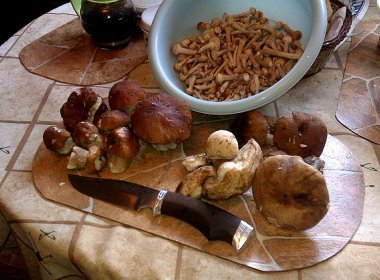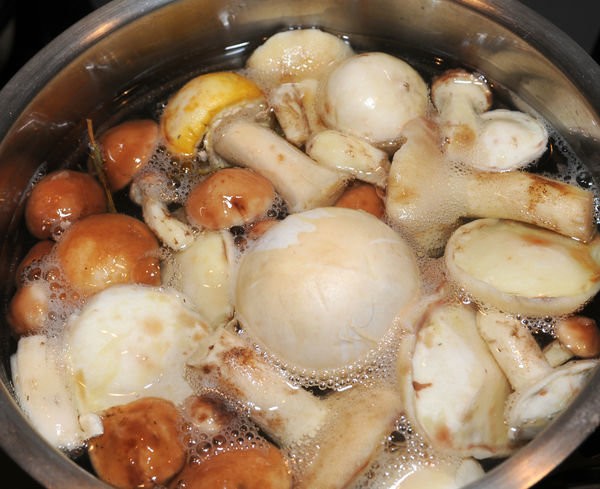Mushroom processing after harvest
Mushrooms are exposed to high temperatures in order to completely or partially eliminate their toxicity, bitter taste or unpleasant odor. It should be remembered that such processing impairs the nutritional quality of mushrooms, and also weakens their aroma and taste. Therefore, if there is such an opportunity, it is better not to boil the mushrooms at all, but to fry them in their natural, fresh form. This is quite possible with chanterelles, mushrooms, champignons, mushrooms, summer mushrooms and young autumn ones, as well as many rows and russula. Let’s say even more: some varieties of mushrooms become viscous after boiling. This happens, for example, with ringed caps, chanterelles, as well as the legs of boletus and boletus. These features are worth knowing when preparing mushroom dishes.
But with some mushrooms, cooking is indispensable. We have to sacrifice nutritional value in order to dissolve harmful substances in water. These mushrooms include: volnushki (pink and white), some russula (brittle and pungent), ordinary lines, milk mushrooms (black and yellow). They need to be boiled for about 15-30 minutes, and then be sure to pour the broth. The bitter taste of some mushrooms (mushrooms, lactifers, serushki, milk mushrooms, bitters, fiddlers, as well as some talkers and russula) is removed by short-term cooking (5-15 minutes is enough). But it is generally useless to cook the gall fungus – the bitterness will not disappear.

First Stage — primary processing of mushrooms. Consists of several consecutive steps:
1) Sort. Different types of mushrooms differ not only in taste, but also in cooking technology. Therefore, pre-sorting does not hurt at all. For example, you can separate mushrooms that need to be boiled from those that can be thrown into the pan fresh. To make it convenient to process mushrooms, it is recommended to arrange them into piles, depending on the size.
2) Clean up debris. Together with mushrooms, we bring leaves, needles, pieces of moss and twigs from the forest that have stuck to hats and legs. All this inedible debris, of course, must be removed – scraped off with a kitchen knife or gently cleaned with a clean cloth. You should be especially careful with mushrooms that are planned to be dried for the winter. Here you can clean the entire surface of the mushroom with a brush, without missing a single fold.
3) Clean with a knife. Some parts of the mushroom are definitely not suitable for food. They must be carefully cut with a knife so as not to risk your health. These are, for example, all softened, damaged or darkened places. If the mushroom is old, then the inside of the cap should also be removed. For some mushrooms, it is recommended to cut off the leg so that the dish does not turn out to be viscous. And in late butter and russula, they clean the hat – there the skin becomes slimy and bitter during the cooking process.
4) Rinse with running water. The mushroom washing time should be short so as not to spoil the taste of this product. If you plan to fry the mushrooms, then it is enough to douse them with cold water. Drying mushrooms are not washed at all. All other processing methods involve a quick wash in cold water and leaning back in a colander to drain excess liquid from the glass. For these purposes, by the way, a sieve or a sloping board without recesses and depressions is also suitable. Some mushrooms have an uneven surface; dust and sand often collect in their folds. These are hedgehogs, lines, morels and some others. Naturally, such species need to be washed a little longer to remove all debris. True, experts say that you still won’t get rid of the sand completely with plain water, and they recommend boiling the mushrooms in boiling water for five minutes, and then drain the water and rinse in a colander.
5) Soak. This is done in order to remove bitter or salty notes from the mushrooms in taste. In this case, it is recommended to change the water once an hour so that harmful substances leave faster. Soaking also helps restore dried mushrooms to their original moisture content. Such water can be used as a base for mushroom broth.
6) Cut. This is needed for large mushrooms that cannot be cooked whole. Many people separate the caps from the legs and cook them separately to make the dish or canned food in a jar look more attractive. The hat is cut into an even number of parts (two, four, six – it all depends on the size). The leg is carefully cut across, making sure that the pieces do not turn out too thick.

II stage – subsequent (thermal) processing of mushrooms. Includes several options for you to choose from:
1) Boiling. Boil the water first, add salt to your taste and put the mushrooms. The foam formed during the cooking process must be removed. Boil the mushrooms for about 15-30 minutes. The finished product is thrown into a colander or cooled in cold water.
2) Boiling. Initially, the mushrooms are placed in cold salted water and brought to a boil as quickly as possible. Immediately after boiling, the dishes are removed from the stove. Mushrooms can be gradually cooled in the same water in which they were boiled, or poured over with cold water. When the mushrooms have cooled, they must be placed in a cloth bag or on a sieve to remove any remaining moisture. Mushrooms cannot be squeezed: with this method, along with water, useful substances also irrevocably leave the product.
3) Scalding (or blanching). First, the mushrooms are thoroughly washed, and then they are placed on a sieve or in a colander and doused with very hot water. After that, briefly lowered into boiling water (you can hold it over a pot of boiling water). Blanching is the fastest method of heat treatment. After it, the mushrooms do not break, which is very important if you are going to salt or pickle them. As a rule, mushrooms or russula with a flat or just a large hat are subjected to scalding.
Summary









